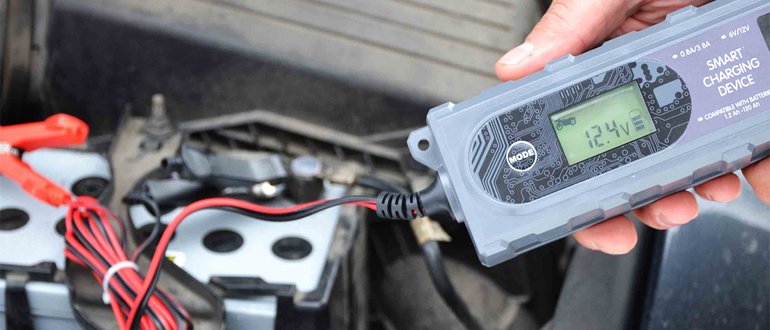The most important operating parameter of a car battery is voltage. A completely dead battery is not only unable to crank the internal combustion engine, but it will not even turn on the emergency lights. In order not to be in a situation where you need to start the car with a pusher or ask for a “light”, you need to know how many volts a fully charged car battery should show.
Content
Why is it important to monitor battery level?
It is important to maintain the required battery level not only during operation, but also when the machine is parked. During long-term storage of the battery, which shows an insufficient voltage level, an oxide film will form on lead plates, which has poor electrical conductivity. For this reason, the battery will noticeably decrease capacity and overall service life.
In the winter season, leaving the car on the street with a discharged battery is fraught with its complete failure. The fact is that if the voltage at the battery terminals is below normal, the density of the electrolyte decreases significantly and the liquid can completely freeze in banks. Expanding ice will destroy the internal electrodes of the product, and the battery will be completely inoperative.
A low battery level during engine start-up will lead to increased long-term loads on the electrical wiring, the brushes of the starter motor and the contacts of the retractor relay.
How to check the charge level
The charge level of many modern battery models can be checked by the indicator built into the top cover. If the “eye” of such a device is green, then the battery is in a fully charged state. You can more accurately determine the value of the potential difference at the terminals of the device using a multimeter.
In order to measure the voltage on the battery with a multimeter, it is enough to put the measuring device in the direct current measurement mode. Then connect the black probe to the negative terminal of the battery, and the red to positive. The digital display will show the voltage value, to the nearest tenth of a volt.
If the battery is serviced, you can determine the charge level using a hydrometer. In a fully charged battery, the electrolyte density will be at least 1.27 g / cm3.
How many volts should a fully charged battery show
The car battery consists of 6 cans, each of which produces a voltage of more than 2 volts. Such individual elements are connected in series, therefore, as a result, the voltage of a fully charged and serviceable battery always exceeds 12 V.
Without load
Without a load at the terminals of a fully charged battery, the voltage will be 12.6 V. On some models, as well as immediately after charging the battery, this value can be in the range 12.9 - 13.2 v.

Under load
Under load, the voltage at the terminals can be significantly lower than the rated voltage. The measurement of this parameter is carried out using a load plug, which is a voltmeter with a low resistance resistor. A fully charged battery should indicate a voltage value of at least 9 volts when connected to a meter.
Thus, with a load plug and a multimeter, you can always accurately determine the state of the car battery, both under load and without it.
Up to how many volts the battery is still charged
If the battery is not already 100% charged, then each owner of the machine needs to know at what voltage values the battery can still be operated.
Without load
If the current source is not powered by the electrical equipment of the machine, then it must give out at least 11.9.
Under load
Under load, the potential difference across the terminals must not fall below 9 V.
If the voltage indicators are lower than the above values, then the battery must be connected to the charger as soon as possible.
At what voltage do you need to charge
Timely recharging of a dead battery will allow you to fully restore its capacity and avoid the damaging effects of sulfation and frozen water in the winter on lead plates.
With the following voltage indicators, the battery terminals must be put on charge:
- No load below 11.9 V.
- Under load below 6 V.
As a rule, in this state, the battery is no longer able to cope with the start of the internal combustion engine.
| Level charge | 12 volt | Density electrolyte |
|---|---|---|
| The engine should start without problems | ||
| 100 % | 12.7 | 1.265 |
| 95 % | 12.64 | 1.257 |
| 90 % | 12.58 | 1.249 |
| 85 % | 12.52 | 1.2451 |
| 80 % | 12.46 | 1.233 |
| 75 % | 12.4 | 1.225 |
| 70 % | 12.36 | 1.218 |
| 65 % | 12.32 | 1.211 |
| 60 % | 12.24 | 1.204 |
| 55 % | 12.1 | 1.197 |
| 50 % | 12 | 1.19 |
| 40 % | 11.9 | 1.176 |
| Engine may have difficulty starting up or not starting up | ||
| 30 % | 11.75 | 1.162 |
| 20 % | 11.58 | 1.148 |
| The battery is completely discharged and does not show signs of life. | ||
| 10 % | 11.31 | 1.134 |
| 0 % | 10.5 | |
Try not to keep the battery in the border area.
How does ambient temperature affect charge level
At negative air temperatures, the rate of chemical reactions slows significantly. As a result of this, in the winter season, the battery level will be slightly lower, and electricity consumption will also increase significantly due to the heavier crankshaft cranking due to thickened engine oil.
When used in hot climates, a normally charged battery is capable of delivering a greater amount of electricity, but at the same time, self-discharge of the battery will noticeably increase.
In general, if the battery is operated in extreme conditions, its technical condition should be observed more closely than when used in the temperature range recommended by the manufacturer.
Have questions or have something to add? Then write to us about it in the comments, this will make the material more complete and accurate.







